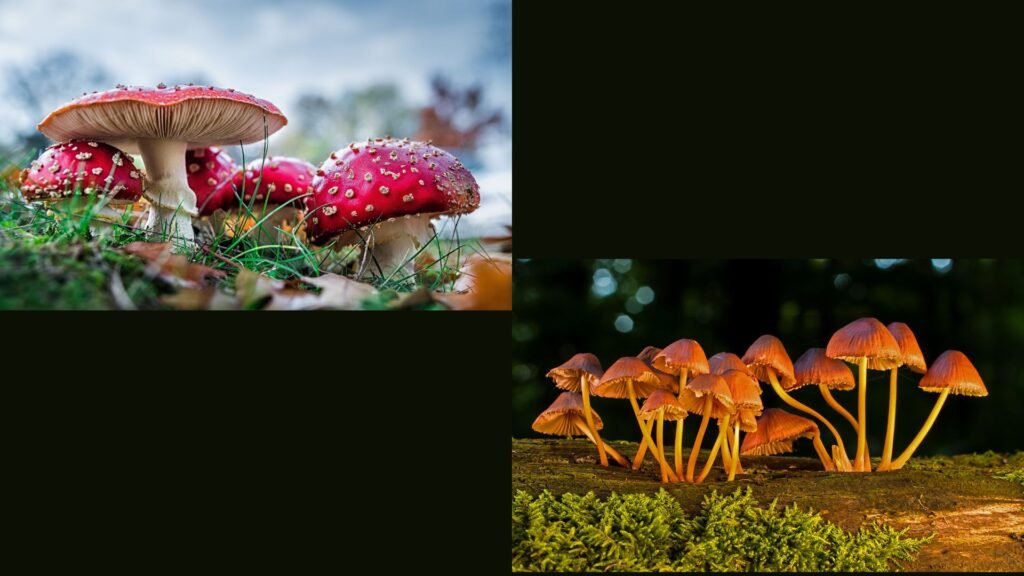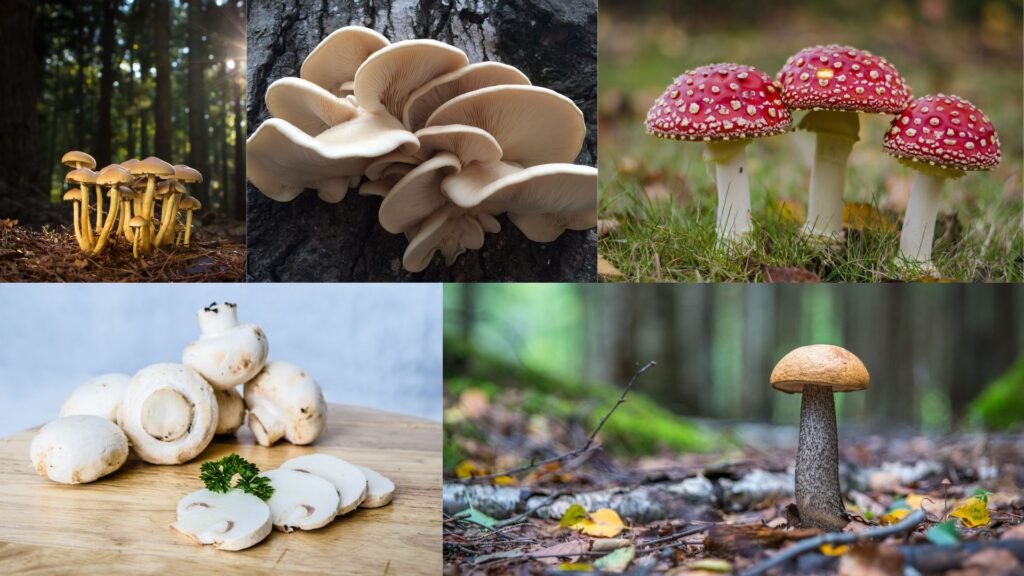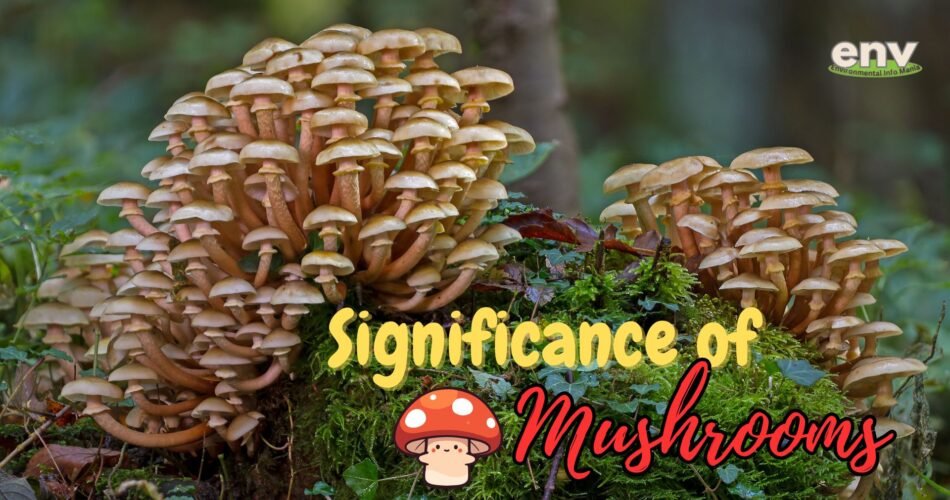This blog contains complete information about classification and Environmental Significance of Mushrooms. It also contains the Amazing Facts about Mushrooms along with their Uses in Human Life. You will have a complete description of Mushrooms in detail.
What are Mushrooms?
Mushrooms are umbrella-shaped fruiting body of certain fungi mostly found above the ground. These are spore-bearing and are significant in ecosystems because of decomposing Organic Matter.
The Mushrooms are important part of Ecosystems. They belongs to Order Agaricales in the phylum Basidiomycota. Particularly the term mushrooms is to identify edible Sporophores. A large variety of mushrooms are healthy and used as food, while some of the wild mushrooms are poisonous in nature. Some are beneficial for health while some can be fatal. They also provide many Environmental benefits such as decomposition or decay of Organic Matter, Carbon cycling and much more.
When we talk about the characteristics of fungi, they are a bioindicator by nature. In unfavorable conditions, fungi show morphological and physiological changes to respond stress on the ecosystem. They indicates the health, survival and reproduction of living species in their environment. This is the reason why mushrooms are for excellent use and research. This blog contain Classification and Environmental Significance of Mushrooms.
What is Myco-forestry?
Mycology is the study of fungi within forest ecosystem examining their roles in stabilizing the whole resilience of forest ecosystem. Myco-forestry is the ecological forest management system implemented to enhance forest ecosystem and plant communities. Myco-forestry is a very effective restoration practice for ecosystem. It provides water and nutrients to the forest biodiversity and also takes part in many useful ecosystem services such as Carbon sequestration, nutrient cycling, decomposition and many other such processes that lead to Ecosystem restoration.
Mushroom Farming
Mushroom farming also known as fungiculture, is the practice of cultivating fungi specifically mushrooms. This involves establishing controlled environments for better growth of useful species of mushrooms. The process of mushroom farming includes the selection of mushroom, substrate preparation, spawn inoculation, monitoring, maintenance and harvesting. Mushrooms are cultivated on commercial levels. Commercial cultivation of mushrooms provides following benefits:
- High-value crop
- Minimal Space requirement
- Multiple harvests
- Nutritional benefits
- Medicinal properties etc.
Explain the classifications of Mushrooms?
Saprotrophs, Mycorrhizal & Parasitic Formers:
Saprotrophic mushrooms
These mushrooms break down dead organic matter. This type is specialized for nutrient cycling and soil health.
Mycorrhizal fungi
These form symbiotic relationships with plant roots, enhancing water and nutrient uptake, improving plant‑fungus symbiosis.
Parasitic mushrooms
These mushrooms impact host organisms but can also regulate ecosystem population dynamics.
Mushrooms are of a wide variety, that are used for different purposes. These contains many shapes and sizes and they are worth watching. Following are some of the main types of Mushrooms:
1: Edible Mushrooms:
Edible mushrooms as mentioned in their name, are fit for eating purposes and are healthy for humans and Biodiversity. These are widely used in cooking. We cultivate some of the mushrooms commercially in Mushroom Farms in controlled conditions.
Examples of Edible Mushrooms:
Portobello, baby bellas, whites etc.
2. Toxic Mushrooms:
Toxic Mushrooms are secondary metabolites, these can be toxic, mind altering, antibiotic etc. Some of these are deadly poisonous while other shows allergic and unpleasant symptoms in different ways. On the other hand they absorb heavy metals and even some radioactive metals from soil.
Examples of Toxic Mushrooms:
Death cap, Fly agaric, Satan’s bolete etc.
3. Psychoactive Mushrooms:
Psychoactive Mushrooms plays a vital role in the Native medicine in several cultures around the world. They are a great medication for physical and also mental healing. These mushrooms provide spiritual experiences and in recent research it is scientifically accepted.
Examples of Psychoactive Mushrooms:
Magic Mushrooms, Wavy cap, Laughing Gym etc.
4. Medicinal Mushrooms:
Many of the mushrooms in above types and many other than these mushrooms are used for producing medicine. In many countries, cancer therapies, and many other such treatments are carried out by Mushrooms. These is are not proven clinically safe yet.
Examples of Medicinal Mushrooms:
Turkey tails, Shiitake, China root etc.
Edible vs Poisonous Mushrooms:
- Edible mushrooms are safe and healthy to eat. Poisonous mushrooms contain toxins and cause illness or death.
- We cannot rely on the taste and smell. Even some deadly mushrooms have pleasant smell and taste.
- Edible Mushrooms have black, brown or white spores. While poisonous ones have rusty brown spores.
- Eatable mushrooms does not stain when they are cut. Most of the Poisonous mushrooms turn blue or stain when cut.
- Edible ones mostly grows in specific environments. While toxic mushrooms are expected to grow in decaying wood.
These are some of the major types of Mushrooms. All of these have different purposes, advantages and disadvantages. This blog contain Classification and Environmental Significance of Mushrooms.

What is the Environmental Significance of Mushrooms?
Mushrooms not only facilitates us in medicinal and food sectors. But it also provide many of the Environmental Benefits in the Ecosystems. Even the toxic species of the Mushrooms are very beneficial for the Environment. Among all the useful species in the Environment, mushrooms are one of them playing some significant roles in the Environment in maintaining Ecosystems. Following are some of the Environmental Benefits of Mushrooms:
1) Soil Health:
Mushrooms help out in maintaining soil health. This becomes possible as it helps and facilitates in breaking down plant and animal debris and thus increase the nutrient availability in the soil. Another quality of mushrooms that helps in maintaining the soil health is that the compost and nutrients that we provide for mushroom growth, returns back to the soil to nourish future crops. This makes it useful and beneficial for a long time. There is an improvement in soil quality in the presence of mushrooms and it maintains till the mushrooms are present and survives in the soil.
2) Carbon Cycling and Carbon Sequestration:
Mushrooms also play a significant role in Carbon Cycling. It contributes in various steps of Carbon Cycling that helps for absorb and return of Carbon in the Ecosystem. Following are the roles of Mushrooms that it plays in Carbon Cycling:
- Decompose organic matter and take out Carbon from it.
- Its stores carbon in its structure.
- Captures carbon from the atmosphere.
- Increase soil fertility by sequestering and also storing carbon from soil.
- Helps in reducing excess Carbon from the Environment.
All of these mechanisms contributes in maintaining and completing Carbon cycle into the Environment. This is the most significant Environmental benefit of mushrooms. We can cultivate mushrooms in order to speed up the Carbon cycling and maintaining Soil health of the area.
3) Nutrient Exchange:
Nutrient exchange is also one of the remarkable characteristic and Environmental Benefit of the Mushrooms. Most of the time Mushrooms creates symbiotic relationship with Trees and Mycorrhiza. This relationship is two ways. The role of Mushrooms in this symbiotic relationship is to extract minerals and water from the soil, while the role of Tree is to provide Sugar compounds to the Mushrooms. In this way, Trees and mushrooms help each other to survive in wild and terrestrial environment. This also takes a part of Nutrient Recycling into the Environment. This is a great property of Mushrooms.
4) Decomposition:
Mushrooms are also famous for decomposition of the Organic Matter in the soil. It decomposes the dead bodies of Plants and animals and returns the Nutrients to the soil in order to increase its fertility. The decomposition does not restricts to Organic Matter, as Mushrooms also degrade and decompose Complex Toxic Chemicals and Contaminants into the soil. It converts all the contaminants in simpler forms that microorganisms can easily degrade them and add them into the soil. This can also refers as Environmental Cleanup because it cleans the contaminated soil in the Environment.
5) Removal of Unsustainable Materials:
The Mushrooms also have a remarkable property to remove unsustainable or Environmentally hazardous materials in order to clean the soil and increase soil productivity. Some small microplastic adds into the soil and with passing time, they may reach to the root region or burry under the mud. Mushrooms got a special property of removing plastics, and other unsustainable and toxic materials through their roots. This helps in reducing Land Pollution in that specific area and it also protects the nearby trees and plants from the contaminants and toxic materials by removing them from the soil.
6) Bioremediation:
Bioremediation is the term used to describe the use of living organisms in order to remove pollutants from the soil. This property of Mushrooms is already discussed in the above headings. Mushrooms have special feature of treating and removing pollutants and toxic compounds from the soil. This property helps in the maintenance of Soil Quality, Nutrient Availability and living Ecosystem of an Area. We can treat bad quality soil particles by exposing them to Mushrooms in order to remove pollutants and contaminants from the soil to improve Soil Fertility and Soil Quality.
These are some of the Environmental Benefits of Mushrooms. They are very important in maintaining and establishing the Natural Environment in the Ecosystem. They also maintain Nutrient balance in the Environment. This blog contain Classification and Environmental Significance of Mushrooms.
What are some Amazing Facts about Mushrooms?
Mushrooms are one of the remarkable living organisms on Earth. They posses many unique characteristics and qualities that are good for the Environment and Ecosystem. Here we will discuss some of the Amazing Facts about Mushrooms.
Mushrooms are Fungi not Plants:
Mushrooms looks like plants, grow with plants and survive in the Environment in which plants survive. But interesting fact is that, they are not plants and characterized as Fungi. They are fungi because they do not support photosynthesis and cannot make their own food. These absorb and extracts food materials from other organisms or materials around them. They take sugar compounds from Trees. This is apparently unbelievable that Mushrooms are not plants.
Establishes Mycorrhizal Networks:
As Mushrooms takes food and nutrients from other materials, so they establish Mycorrhizal Networks with trees. These networks work for the transfer of food and information. With these networks mushrooms shares and receives information from the trees and use it for further working. This is one of the distinguishing property of Mushrooms among different types of Biodiversity.
Bioluminescence:
Bioluminescence is the property in which a living material glows or lights up in the dark Environment. This property is present in all the organisms who lights up in the dark and show brightness. The bioluminescence is also a property of some of the rare mushrooms. They are ordinary type of mushrooms in the day time, but as darkness appears, they lights up and shows brightness in the dark. It is an amazing fact about mushrooms.
Largest Organism is a Mushroom:
Mushrooms are mostly very small in size, we use them for cooking purposes and for different uses. We can easily harvest them and use them for different purposes. But do you have any idea, that the worlds Largest living organism on Earth is a Mushroom. It is a honey mushroom present in Oregon USA. This Mushroom is large enough to cover a very large area of 2385 Acres or 965 hectares. This is the most amazing fact about the Mushrooms.
Diverse Species:
Mushrooms have a wide variety of species. They contain different Characteristics, shapes, sizes and way of living in the Environment. There are diverse variations and alterations in Mushrooms. According to research, there are over 10,000 species of Mushrooms that have distinct characteristics and it is a perception that many of the species are yet to be discovered in Future. Scientists are still exploring Mushrooms because of its wide diversity.
Mushrooms in Ancient Medicine:
Mushrooms are existing in the Environment from ancient times. The prediction about existence of Mushrooms is to be for over 1 Billion years on the Earth. This shows that Mushrooms are one of the oldest living organisms on Earth and the Environment. The fact that Mushrooms are ancient organisms explains that these organisms have made their survival possible in terrestrial Environments and they also remain persisted in the Environment. This is the most incredible fact about Mushrooms. So, we observe the use of mushrooms in medicine in ancient time.
Psychedelic Mushrooms and Neurobiology:
Psychedelic Mushrooms are also called as Magic Mushrooms. These have great significance in neurobiology. Magic Mushrooms contain Psychoactive compounds called psilocybin and psilocin. They are famous for inducing altered state of consciousness. This have many advantages for health as it has a great therapeutic potential, enhance creativity and insight, increase empathy and connection etc. These mushrooms can produce euphoric feelings and are able to cure mental health conditions more effectively than other plants and materials.
Mushroom Hunting Tradition:
Mushroom foraging or hunting is an important tradition in Baltic and Slavic countries. This hunting is basically related to food that they can get from mushrooms. The major part of hunting is edible mushrooms to be used as food. This is the traditional and cultural activity for the families. By this hunting they have came to know which mushroom is poisonous and which one is edible. People gather and prepare for this hunting and collect edible mushroom for their families. It a unique activity in the world performed by some of the nations on Earth.
These were some of the Amazing and Incredible Facts about Mushrooms. In the present time Mushrooms are frequently used by Humans and other Biodiversity. They posses many distinct properties among other organisms found in the Biodiversity. This blog contain Classification and Environmental Significance of Mushrooms.
What are the common Uses of Mushrooms in Human Life?
Mushrooms are beneficial living Fungi that helps humans and Biodiversity for various purposes and daily life routine. We are going to discuss some most common uses of Mushrooms in our lives. Following are the Common Uses of Mushrooms:
- Mushrooms are widely used in cooking in Chinese, Japanese, Korean and European cuisines.
- These contains Vitamin D, no cholesterol and also other micronutrients that are good for health of humans and animals.
- They are used for producing medicines and in various clinical therapies such as Cancer treatment etc.
- Mushrooms also contain spiritual and mental health healing characteristics that are common in various cultures.
- Mushrooms are also used for making dyes and also utilized in Genetic Engineering.
- We can get Biodegradable packaging by Mycelium and is also useful.
These are some of the uses of Mushrooms. People gets many benefits from mushrooms in different sectors and lifestyle practices. We should work on Mushroom Farming of suitable species and use them for benefit of humans and Biodiversity. This blog contain Classification and Environmental Significance of Mushrooms.
What is the importance of Mushroom in Forest Ecosystem?
Following are some points showing the importance of Mushrooms in Forest:
Mycorrhizal Relationship
Mushrooms are specialized for establishing symbiotic relationship with tree roots called Mycorrhizae. In this relationship fungi help trees to absorb nutrients and waters, while trees provide sugars to the mushrooms for further growth and nourishment.
Pioneer Species
In the areas where the ecosystem is disturbed, mushrooms acts as pioneer for many species. They recycle and decompose essential nutrients and provide establish suitable habitats for new species to grow and replenish in the forest region.
Habitat Provision
With making forest suitable for other species, mushrooms also provide microhabitats to microorganisms and also tiny animals in the forest ecosystem. This is one of the significant role of mushrooms in forests and in maintaining overall ecosystem stability.
Other important roles of Mushrooms in forest ecosystem includes Carbon Cycling, Decomposition, removal of harmful substances etc. This blog contain Classification and Environmental Significance of Mushrooms.
What is the Impact of Climate Change Fungal Biodiversity?
Fungal Biodiversity is highly disturbed by the extreme impacts of Climate Change. Following are some impacts of Climatic Changes on varieties of Fungi:
Shifting of Geographical Ranges
Due to unusual shifting of temperature, the geographical ranges are changing with time. This highly effects Fungi species.
New Fungal Pathogens
Fungal pathogens are a great threat to Fungi populations. New fungal pathogens are increasing because of changing climate.
Disrupted Ecosystem
Due to Climate Change the ecosystem of natural habitats are disrupted and species are harmed including Fungi ones.
Development of thermotolerance
Fungi are developing tolerance to heat. This can be dangerous for humans who consume them in their routine life.
Increased Virulence and Pathogenicity
The continuous disturbance in climatic conditions is causing more pathogens and diseases in fungi populations.
These are few major impacts of Climate Change on Fungal Biodiversity. Some other impacts includes health effects in humans, unusual changes in fungal species and mushrooms etc. There is need for further research for understanding new changes in fungi populations and Climate Change Mitigation and Adaptation is necessary to fight all these environmental issues.

Future of Mushrooms in Sustainability
With rising environmental concerns, mushrooms are gaining attention for:
-
Alternative protein sources (mycoprotein).
-
Eco-friendly materials (mushroom leather, biodegradable products).
-
Urban farming (vertical mushroom cultivation).
Conclusion:
Mushrooms are extremely incredible Fungi species that facilitates us with many daily life activities. These are not only useful for humans in different ways, but they are also beneficial and Significant into the Environment. They provide many ecosystem services such as Carbon Cycling, Decomposition, removal of unsustainable material etc. Mushrooms also have some interesting facts such as; they show Bioluminescence, Diverse Species, Largest Organism, Fungi specie etc. Mushrooms are very beneficial for us in multiple ways. We should consider and promote the Farming of suitable and useful species of Mushrooms so as to utilize them for different beneficial purposes. This blog contain Classification and Environmental Significance of Mushrooms
To learn more, Click the links below:


Comments